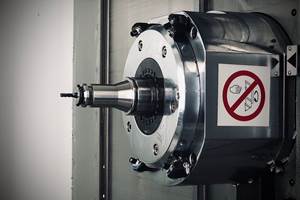Video: Form Tools On CNC Lathes
Form tools are traditionally associated with non-CNC machines, but in certain applications they make sense on modern machines as well.
Share




On a CNC lathe or turning center, one way to machine a complex cylindrical profile is obvious. That is: program a single-point turning insert to feed along the geometry of that profile. It might seem that there is no other way.
However, there is also a method for machining these profiles that preceded the development of CNC. And in certain applications—even on CNC machines—this is still the more efficient approach. That method involves form tools.
Indeed, according to form tool maker Schwanog, CNC machining processes now account for the majority of the company’s sales for this type of tooling.
Form tools are custom inserts. The cutting edge matches the intended profile of the part. As a result, a single straight plunge with the insert produces the desired shape. This has long provided a way for non-CNC production equipment such as automatic screw machines to achieve complex turned profiles, so it might seem counter-intuitive to forgo programmability in order to use the same kind of custom tooling on a CNC machine. Yet Schwanog U.S. general manager Holger Johannsen says there are important advantages of form tools that, in the right applications, make them more cost-effective than standard turning inserts on CNC equipment.
The most significant of these advantages is time. The video above illustrates this. When the same turned profile is machined with a form tool against a series of single-point cutters, the simple in-out stroke of the form tool allows the profile to be machined in about one-third of the time. Given a large enough volume, this time savings can become attractive enough to justify the investment in the custom tool.
But perhaps surprisingly, accuracy also figures into the use of this tooling. The reason relates to reduced variables. A standard turning tool following an interpolated path involves two machine axes where a form tool uses only one machine axis. With fewer moving elements to contribute to process error, the form tool can often make it easier to consistently achieve tight precision.
Mr. Johannsen says one further advantage is finish. With a single-point tool, inevitably there are cusps between rotations of the workpiece as the cutting edge travels along the contour. A form tool omits these cusps, because the entire segment of the part represented by the form is machined in a single plunge.
Every form tool is a special order. Each is engineered to geometry provided by the end user. This obviously means there is significant additional cost involved in specifying the form tool instead of a standard tool. The applications that can benefit from one or more of the advantages above—cycle time, accuracy or finish—are the ones that can justify the expense.
Still, a direct price comparison between standard and custom tooling does not necessarily account accurately for the cost difference, Mr. Johannsen says. One additional factor is tool life. When a single-point insert machines all the way along some profiled segment of the part, all of the energy of the cut contributing to tool wear is concentrated into that single narrow “point” of contact between the cutter and the part. By contrast, the form tool cuts along a line of contact, with the energy of the cut distributed along the profile. As a result, a form tool can be counted on to wear much more slowly—not only reducing the rate at which new inserts need to be purchased, but also reducing the amount of time that is lost to tool replacement.
Related Content
Selecting a Thread Mill That Matches Your Needs
Threading tools with the flexibility to thread a broad variety of holes provide the agility many shops need to stay competitive. They may be the only solution for many difficult materials.
Read MoreQuick-Change Tool Heads Reduce Setup on Swiss-Type Turning Centers
This new quick-change tooling system enables shops to get more production from their Swiss turning centers through reduced tool setup time and matches the performance of a solid tool.
Read MoreHow to Troubleshoot Issues With Tool Life
Diagnosing when a tool is failing is important because it sets an expectation and a benchmark for improvements. Finding out why gives us a clue for how to fix it.
Read MoreThe Future of High Feed Milling in Modern Manufacturing
Achieve higher metal removal rates and enhanced predictability with ISCAR’s advanced high-feed milling tools — optimized for today’s competitive global market.
Read MoreRead Next
Registration Now Open for the Precision Machining Technology Show (PMTS) 2025
The precision machining industry’s premier event returns to Cleveland, OH, April 1-3.
Read MoreBuilding Out a Foundation for Student Machinists
Autodesk and Haas have teamed up to produce an introductory course for students that covers the basics of CAD, CAM and CNC while providing them with a portfolio part.
Read MoreSetting Up the Building Blocks for a Digital Factory
Woodward Inc. spent over a year developing an API to connect machines to its digital factory. Caron Engineering’s MiConnect has cut most of this process while also granting the shop greater access to machine information.
Read More

















.jpg;maxWidth=300;quality=90)








.jpg;maxWidth=300;quality=90)








